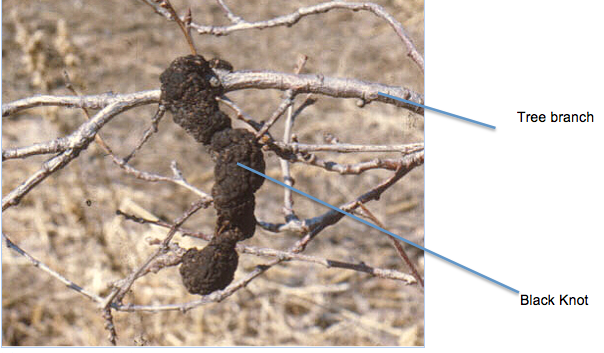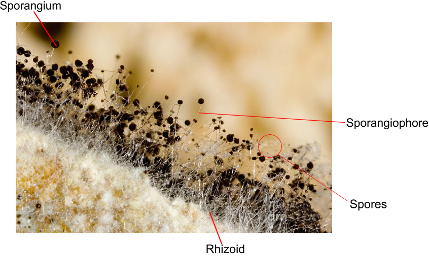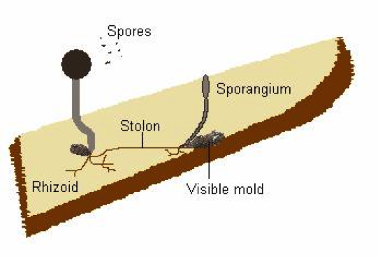1. Most are multicellular, but yeast are a unicellular exception.
2. Most are heterotrophs.
3. Their cells have cell walls made of chitin.
4. They can reproduce sexually or asexually through spores.
5. They are similar to Protists because they can reproduce sexualy or asexualy, and they are both sometimes autotrophs and sometimes heterotrophs.
Organism 1: Black Knot
Kingdom: Fungi
Phylum: Ascomycota
Subdivision: Pezizomycotina
Class: Dothideomycetes
Order: Pleosporales
Family: Venturiaceae
Genus: Dibotryon
Species: D. morbosum

Figure 24: Black Knot
Dibotryon morbosum is a fungus that is the agent for black knot. It is a plant pathogen that affects trees in North America such as, apricot, cherry, chokecherry, and plum. The disease makes large, round, black structures on the trees that are called galls or knots. These knots then kill the affected parts of the tree. If the disease progresses and the infected areas of the tree increase, the tree usually dies or stops growing. The fungus can be spread sexually or asexually [26]. Additionally, Insects often live in the black knots which eventually can cause an infestation that kills the tree.. If a tree has black knot, removing the affected limb and treating the wound can treat it. In addition any fruits nearby need to be killed to prevent the disease from spreading. The knots range in size from one inch to one foot [27].
Why does it belong?
Dibotryon morbosum belongs in the kingdom of fungi because it has chitin in its cell walls. Additionally it is a heterotroph, which is another characteristic of fungi.
Organism 2: Black Bread Mold (Rhizopus stolonifer)
Kingdom: Fungi
Order: Mucorales
Family: Mucoraceae
Genus: Rhizopus
Species: R. stolonifer

Figure 20: Rhizopus stolonifer

Figure 25: Bread mold diagram
Rhizopus stolonifer is a mold commonly found on bread surfaces. It destroys the surface that it lives on by taking different nutrients from it that it needs to survive. R. stolonifer grows at temperatures ranging from 15 to 30 degrees Celsius. It a member of phylum Zygomycota. It is the most common and fastest growing of all of the members of that phylum [28]. Rhizopus stolonifer has spores that are constantly floating around in the air. While they can most commonly be found in breads and fruits, they can also be found in soil, and litter. This is because they need to live in warm and dry environments [29]. They are parasitic to their surfaces since they take all of the nutrients from whatever they are growing on and give nothing back. There are benefits and drawbacks to black bread mold. They can cause sickness in humans and remove nutrients without giving anything back, which is bad. However, they decompose soil, which helps the carbon cycle and is beneficial to the environment. Rhizopus stolonifer ranges from 300 to 350 um in length [28].
Why does it belong?
Rhizopus stolonifer is considered part of the fungi kingdom because it contains the characteristics of that kingdom. First, it has chitin in its cell walls, which is unique to fungi. Rhizopus stolonifer has spores that float around in the air, which is how it moves around, and it also continues to grow. Rhizopus stolonifer is a heterotroph, which is another characteristic of fungi.